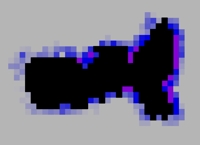| |
Projects:
Remote Sensing
2003 |
| Application
of orbital remote sensing data (AVHRR) to the detection and analysis of
local sea surface temperature anomalies |
Several factors may cause
local to large-scale anomalies of the sea surface temperature (SST).
The small-scale anomalies induced by submarine freshwater springs in
coastal areas are herein of special interest. |
 Negative
SST-anomaly map of Elba Island, created with the AVLA81-filter (3-month
averaged data, 2000). Strongest anomalies are coded violet. Negative
SST-anomaly map of Elba Island, created with the AVLA81-filter (3-month
averaged data, 2000). Strongest anomalies are coded violet.
|

|
In order to analyze the
distribution of regional SST-anomalies over
large areas with a medium spatial resolution a dedicated filter (AVLA
– Absolute versus Local Average [SST]) was defined. This
algorithm, a strongly modified multi-staged low-pass-convolution-filter
is applied with a 9x9 kernel window (AVLA81) on weekly MCSST-maps
provided by the orbital NOAA-AVHRR-scanner system (approx. 1 km spatial
resolution). The statistical reliability of the filter was
mathematically tested. It can be shown that a
SST-difference of 1K calculated by using the AVLA81-algorithm is
sufficient to determine a real „absolute“
SST-anomaly. Furthermore
the calculated
value interval of 0.2-1 K can be assumed as a reliable trend
indicator.
Possible
influences to the accuracy and reliability of data were
discussed, including geometry of cloud casting and coastal topography,
surf zone effects, upwelling as well as the influence of size and
geometry of the anomalies related to the calculating method.
It can be demonstrated that seasonality of overall SST values is a very
important factor in the interpretation of AVLA values. This signal may
well suppress possible non-seasonal variations of the anomaly signal in
areas of dominant seasonal SST variations. At present, only the
consistency of anomaly development at discrete seasons over several
years can be compared objectively. This goal is supported by a
long-term (3 month used in this work) AVLA-value averaging, targeting
to
an elimination of ephemeral short-time anomalies (as produced by eddies
etc.) and pronouncing long-time anomaly zones (as produced by
freshwater discharge) in the data record.
The potential practical application of the anomaly detection, esp. with
the
purpose of exploration for coastal submarine freshwater sources, were
demonstrated by two examples (Elba Island, coastal regions
of Tunisia). In these, the AVLA81 data have been supported by the use
of LANDSAT-TM scenes. | | Diploma-Thesis,
completed 12/2003, Supervisors: B. Rein, F. Sirocko, D. Ortlam |
|
|
|





